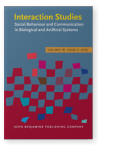Deroy, Ophelia, Louis Longin & Bahador Bahrami
2024.
Co‐perceiving: Bringing the social into perception.
WIREs Cognitive Science 
Dubois-Sage, Marion, Baptiste Jacquet, Frank Jamet & Jean Baratgin
2024.
People with Autism Spectrum Disorder Could Interact More Easily with a Robot than with a Human: Reasons and Limits.
Behavioral Sciences 14:2
► pp. 131 ff.

Ishikawa, Kenta, Takato Oyama, Yoshihiko Tanaka & Matia Okubo
2024.
Perceiving social gaze produces the reversed congruency effect.
Quarterly Journal of Experimental Psychology 
Robert, Lionel P., Marcelo Fantinato, Sangseok You & Patrick C. K. Hung
2024.
Social Robotics Business and Computing.
Information Systems Frontiers 26:1
► pp. 1 ff.

El-Muhammady, Muhammad Faisal, Sarah Afiqah Mohd Zabidi, Hazlina Md. Yusof, Mohammad Ariff Rashidan, Shahrul Na’im Sidek & Aimi Shazwani Ghazali
2023.
Initial Response in HRI: A Pilot Study on Autism Spectrum Disorder Children Interacting with a Humanoid QTrobot. In
Robot Intelligence Technology and Applications 7 [
Lecture Notes in Networks and Systems, 642],
► pp. 393 ff.

Morgan, Emma J., Daniel T. Smith & Megan Freeth
2023.
Gaze cueing, mental States, and the effect of autistic traits.
Attention, Perception, & Psychophysics 85:2
► pp. 485 ff.

Ciardo, F., D. De Tommaso & A. Wykowska
2022.
Human-like behavioral variability blurs the distinction between a human and a machine in a nonverbal Turing test.
Science Robotics 7:68

Willemse, Cesco, Abdulaziz Abubshait & Agnieszka Wykowska
2022.
Motor behaviour mimics the gaze response in establishing joint attention, but is moderated by individual differences in adopting the intentional stance towards a robot avatar.
Visual Cognition 30:1-2
► pp. 42 ff.

Kompatsiari, Kyveli, Francesco Bossi & Agnieszka Wykowska
2021.
Eye contact during joint attention with a humanoid robot modulates oscillatory brain activity.
Social Cognitive and Affective Neuroscience 16:4
► pp. 383 ff.

Schellen, Elef, Francesco Bossi & Agnieszka Wykowska
2021.
Robot Gaze Behavior Affects Honesty in Human-Robot Interaction.
Frontiers in Artificial Intelligence 4

Chevalier, Pauline, Kyveli Kompatsiari, Francesca Ciardo & Agnieszka Wykowska
2020.
Examining joint attention with the use of humanoid robots-A new approach to study fundamental mechanisms of social cognition.
Psychonomic Bulletin & Review 27:2
► pp. 217 ff.

Marchesi, Serena, Davide Ghiglino, Francesca Ciardo, Jairo Perez-Osorio, Ebru Baykara & Agnieszka Wykowska
2019.
Do We Adopt the Intentional Stance Toward Humanoid Robots?.
Frontiers in Psychology 10

Perez-Osorio, Jairo & Agnieszka Wykowska
2019.
Adopting the Intentional Stance Towards Humanoid Robots. In
Wording Robotics [
Springer Tracts in Advanced Robotics, 130],
► pp. 119 ff.

Kompatsiari, K., J. Perez-Osorio, D. De Tommaso, G. Metta & A. Wykowska
2018.
2018 IEEE/RSJ International Conference on Intelligent Robots and Systems (IROS),
► pp. 3403 ff.

Kompatsiari, Kyveli, Francesca Ciardo, Vadim Tikhanoff, Giorgio Metta & Agnieszka Wykowska
2018.
On the role of eye contact in gaze cueing.
Scientific Reports 8:1

Kompatsiari, Kyveli, Francesca Ciardo, Vadim Tikhanoff, Giorgio Metta & Agnieszka Wykowska
2021.
It’s in the Eyes: The Engaging Role of Eye Contact in HRI.
International Journal of Social Robotics 13:3
► pp. 525 ff.

Perez-Osorio, J., D. De Tommaso, E. Baykara & A. Wykowska
2018.
2018 27th IEEE International Symposium on Robot and Human Interactive Communication (RO-MAN),
► pp. 152 ff.

Willemse, Cesco, Serena Marchesi & Agnieszka Wykowska
2018.
Robot Faces that Follow Gaze Facilitate Attentional Engagement and Increase Their Likeability.
Frontiers in Psychology 9

Grynszpan, Ouriel, Jacqueline Nadel, Jean-Claude Martin & Philippe Fossati
Kompatsiari, Kyveli, Vadim Tikhanoff, Francesca Ciardo, Giorgio Metta & Agnieszka Wykowska
2017.
The Importance of Mutual Gaze in Human-Robot Interaction. In
Social Robotics [
Lecture Notes in Computer Science, 10652],
► pp. 443 ff.

Natale, Lorenzo, Chiara Bartolozzi, Daniele Pucci, Agnieszka Wykowska & Giorgio Metta
2017.
iCub: The not-yet-finished story of building a robot child.
Science Robotics 2:13

Wykowska, Agnieszka, Thierry Chaminade & Gordon Cheng
2016.
Embodied artificial agents for understanding human social cognition.
Philosophical Transactions of the Royal Society B: Biological Sciences 371:1693
► pp. 20150375 ff.

This list is based on CrossRef data as of 4 july 2024. Please note that it may not be complete. Sources presented here have been supplied by the respective publishers.
Any errors therein should be reported to them.
